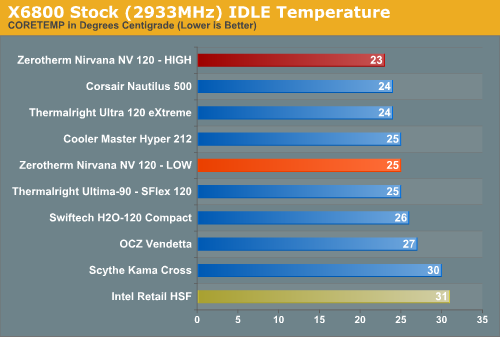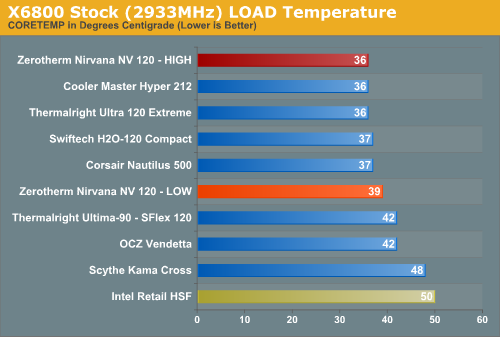ZEROtherm Nirvana: Designed for Top Performance
by Wesley Fink on January 16, 2008 5:00 PM EST- Posted in
- Cases/Cooling/PSUs
Cooling at Stock Speed
Some users will never overclock their CPU, but they still want to run the coolest CPU temperatures possible to enhance stability and extend CPU life. We compile all temperature benchmarks with CoreTemp, a public domain utility that is quite stable with reproducible results on the Intel platform. This required retesting a cross-section of the best coolers evaluated so far at AnandTech. To better document performance in the large speed gap between 2.93 GHz and 3.73 GHz, we added the intermediate value of 3.33 GHz to all test results during the retest of the coolers.

The Nirvana is the best cooler at stock idle ever tested at AnandTech. It slightly outperforms the top Thermalright Ultra-120 eXtreme. The very good Intel stock air cooler keeps the X6800 at 31C at idle, compared to the top Thermalright Ultra-120 eXtreme at 24C, Corsair water at 24C, and Swiftech water at 27C. The ZEROtherm Nirvana turns in an excellent idle performance of 23C, which is 1C lower than any previously tested conventional cooler in our tests with CoreTemp. In comparing results, please keep in mind the test results from the new cooling bed using CoreTemp are not directly comparable to earlier cooling results.
It is more difficult to simulate all the various stress conditions a computer may encounter in different operating environments. For most home users, contemporary gaming is one of the most demanding CPU (and system) applications. Therefore, our stress test simulates running a demanding contemporary game. We loop the Far Cry River demo for 30 minutes and capture the CPU temperature with CoreTemp's "logging" option. We report the highest temperature during the load test. Momentary spikes are ignored, as we report a sustained high-level temp that you are likely to encounter in this type of scenario. This test configuration roughly equates to an 80% CPU load test using Intel TAT, another respected program for thermal measurements.
We compare cooling efficiency of the ZEROtherm Nirvana NV120 under load conditions at stock speed to the retail HSF and other recently retested CPU coolers.

The Nirvana also turns in an excellent performance under load at stock speeds. CoreTemp results are 36C, which matches the best air cooler tested so far at AnandTech, the Thermalright Ultra-120 eXtreme. This is a significant improvement over the stock Intel fan, which reaches 50C under load at stock speed in our cooling test bed, and it is an improvement over the earlier and smaller ZEROtherm BTF90.
If you do not plan to overclock the ZEROtherm Nirvana is an outstanding choice. The stock performance at idle and load are the best we have tested - matching or slightly surpassing the Thermalright Ultra-120 eXtreme.










38 Comments
View All Comments
Spanki - Thursday, January 17, 2008 - link
Nice review.Was the Thermalright Ultra 120 Extreme's top overclock (3.94GHz) achieved with one SFlex SFF21F fan? Or two? On a retail cooler? Or a lapped and/or mount-modded one? It would help if you listed the fan(s) used in all tests/charts. Is it safe to assume one fan, unless you specifically state otherwise?
Aside from that, I agree with an earlier poster - a rise-over-meaured-ambient at the time of test would be a much better indicater when we're talking about 1-3C differences in coolers these days.
Amuro - Wednesday, January 16, 2008 - link
Are you sure those are Core Temp readings? They look like Tcase temps to me. I mean the stock Intel cooler idle @ 31C? That's incredible.I compared them to these articles of yours from a year ago, where you used Nvidia Monitor to messure the Tcase temps:
http://www.anandtech.com/showdoc.aspx?i=2937&p...">http://www.anandtech.com/showdoc.aspx?i=2937&p...
http://www.anandtech.com/showdoc.aspx?i=2943&p...">http://www.anandtech.com/showdoc.aspx?i=2943&p...
Wesley Fink - Thursday, January 17, 2008 - link
Those are the CoreTemp readings, which provide a temp reading for each core of the X6800. The results are very consistnet and repeatable across our tests, but they can NOT be compared to earlier nVidia utility readings. The CoreTemp readings are much lower than the nVidia readings, but they are consistent acrss test platforms.Amuro - Thursday, January 17, 2008 - link
That is weird. Core temps (Tjunction) are supposed to be higher than BIOS temps (Tcase). The difference between Tcase and Tjunction should be 15C or +- 3 degress for a C2D dual core, or 10C for a quad core.Amuro - Thursday, January 17, 2008 - link
That is weird. Core temps (Tjunction) temps are supposed to be higher than BIOS temps (Tcase). The difference between Tcase and Tjunction should be 15C or +- 3 degress with C2D dual cores, or 10C for a quad core.Amuro - Thursday, January 17, 2008 - link
That is weird. Core temps (Tjunction) temps are supposed to be higher than BIOS temps (Tcase). The difference between Tcase and Tjunction should be 15C or +- 3 degress with C2D dual cores, or 10C for a quad core.Amuro - Thursday, January 17, 2008 - link
That is weird. Core temps (Tjunction) temps are supposed to be higher than BIOS temps (Tcase). The difference between Tcase and Tjunction should be 15C or +- 3 degress with C2D dual cores, or 10C for a quad core.coolingwine - Wednesday, January 16, 2008 - link
Wesley - always like your analysis.But, what would be really useful is a performance (temp) to noise ratio chart. And make this standard in future analyses.
As you know, there is typically trade-off between temp and noise, much like price/performance. I may be willing to give a little on the OC potential (which is a factor of temp, all things except the HSF being equal) if the noise is less.
Just a thought....
soydeedo - Sunday, January 20, 2008 - link
I second this idea. I find myself swapping between the noise/temp pages constantly to get a better overall picture of cooling performance.PolymerTim - Wednesday, January 16, 2008 - link
Thanks for the great review. I really like how these reviews examine a large variety of coolers from different perspectives (idle/load, with/without OC, noise, etc). I was thinking a bit about the data and had a couple of thoughts/suggestions.I see in your test configuration that ambient temperature is maintained between 20-22 C. It seems to me that a 2 degree range can be important in some of the tests such as idle tests. At stock idle, half of the coolers fall into a 2 C range. I wonder if it is possible to record the actual ambient temperature during testing and then plot increase from ambient for each cooler. I think this could give a little more accuracy to the comparisons.
A minor detail along the same lines; I think it is unnecessary to start the scaling graphs at 0 C. I think a lot of blank space could be saved by starting at 20 C. What do you guys think? Also, maybe this is data overkill, but I would be curious to know the temperature of each cooler at the max stable OC.
-Tim